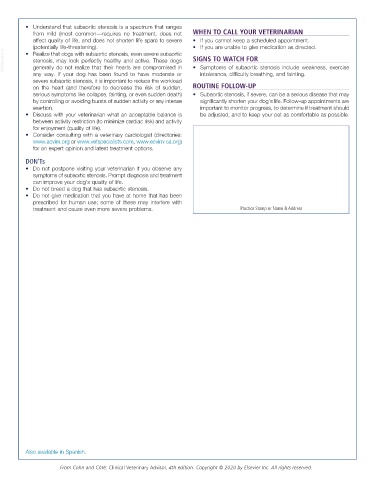Page 3131 - Cote clinical veterinary advisor dogs and cats 4th
P. 3131
• Understand that subaortic stenosis is a spectrum that ranges
from mild (most common—requires no treatment, does not WHEN TO CALL YOUR VETERINARIAN
affect quality of life, and does not shorten life span) to severe • If you cannot keep a scheduled appointment.
(potentially life-threatening). • If you are unable to give medication as directed.
VetBooks.ir stenosis, may look perfectly healthy and active. These dogs SIGNS TO WATCH FOR
• Realize that dogs with subaortic stenosis, even severe subaortic
• Symptoms of subaortic stenosis include weakness, exercise
generally do not realize that their hearts are compromised in
any way. If your dog has been found to have moderate or intolerance, difficulty breathing, and fainting.
severe subaortic stenosis, it is important to reduce the workload
on the heart (and therefore to decrease the risk of sudden, ROUTINE FOLLOW-UP
serious symptoms like collapse, fainting, or even sudden death) • Subaortic stenosis, if severe, can be a serious disease that may
by controlling or avoiding bursts of sudden activity or any intense significantly shorten your dog’s life. Follow-up appointments are
exertion. important to monitor progress, to determine if treatment should
• Discuss with your veterinarian what an acceptable balance is be adjusted, and to keep your pet as comfortable as possible.
between activity restriction (to minimize cardiac risk) and activity
for enjoyment (quality of life).
• Consider consulting with a veterinary cardiologist (directories:
www.acvim.org or www.vetspecialists.com, www.ecvim-ca.org)
for an expert opinion and latest treatment options.
DON’Ts
• Do not postpone visiting your veterinarian if you observe any
symptoms of subaortic stenosis. Prompt diagnosis and treatment
can improve your dog’s quality of life.
• Do not breed a dog that has subaortic stenosis.
• Do not give medication that you have at home that has been
prescribed for human use; some of these may interfere with
treatment and cause even more severe problems. Practice Stamp or Name & Address
Also available in Spanish.
From Cohn and Côté: Clinical Veterinary Advisor, 4th edition. Copyright © 2020 by Elsevier Inc. All rights reserved.

